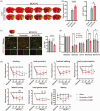Neutrophil-derived cathelicidin promotes cerebral angiogenesis after ischemic stroke
- PMID: 37194247
- PMCID: PMC10414012
- DOI: 10.1177/0271678X231175190
Neutrophil-derived cathelicidin promotes cerebral angiogenesis after ischemic stroke
Abstract
Neutrophils play critical roles in the evolving of brain injuries following ischemic stroke. However, how they impact the brain repair in the late phase after stroke remain uncertain. Using a prospective clinical stroke patient cohort, we found significantly increased cathelicidin antimicrobial peptide (CAMP) in the peripheral blood of stroke patients compared to that of healthy controls. While in the mouse stroke model, CAMP was present in the peripheral blood, brain ischemic core and significantly increased at day 1, 3, 7, 14 after middle cerebral artery occlusion (MCAO). CAMP-/- mice exhibited significantly increased infarct volume, exacerbated neurological outcome, reduced cerebral endothelial cell proliferation and vascular density at 7 and 14 days after MCAO. Using bEND3 cells subjected to oxygen-glucose deprivation (OGD), we found significantly increased angiogenesis-related gene expression with the treatment of recombinant CAMP peptide (rCAMP) after reoxygenation. Intracerebroventricular injection (ICV) of AZD-5069, the antagonist of CAMP receptor CXCR2, or knockdown of CXCR2 by shCXCR2 recombinant adeno-associated virus (rAAV) impeded angiogenesis and neurological recovery after MCAO. Administration of rCAMP promoted endothelial proliferation and angiogenesis and attenuated neurological deficits 14 days after MCAO. In conclusion, neutrophil derived CAMP represents an important mediator that could promote post-stroke angiogenesis and neurological recovery in the late phase after stroke.
Keywords: Ischemic stroke; angiogenesis; cathelicidin; cerebral endothelial cell; neutrophil.
Conflict of interest statement
The author(s) declared no potential conflicts of interest with respect to the research, authorship, and/or publication of this article.
Figures






Similar articles
-
Glycine Receptor Beta Subunit (GlyR-β) Promotes Potential Angiogenesis and Neurological Regeneration during Early-Stage Recovery after Cerebral Ischemia Stroke/Reperfusion in Mice.J Integr Neurosci. 2024 Aug 15;23(8):145. doi: 10.31083/j.jin2308145. J Integr Neurosci. 2024. PMID: 39207064
-
Coicis semen protects against focal cerebral ischemia-reperfusion injury by inhibiting oxidative stress and promoting angiogenesis via the TGFβ/ALK1/Smad1/5 signaling pathway.Aging (Albany NY). 2020 Nov 16;13(1):877-893. doi: 10.18632/aging.202194. Epub 2020 Nov 16. Aging (Albany NY). 2020. PMID: 33290255 Free PMC article.
-
SNHG12 Promotes Angiogenesis Following Ischemic Stroke via Regulating miR-150/VEGF Pathway.Neuroscience. 2018 Oct 15;390:231-240. doi: 10.1016/j.neuroscience.2018.08.029. Epub 2018 Sep 4. Neuroscience. 2018. PMID: 30193860
-
[Tetramethylpyrazine regulates angiogenesis of endothelial cells in cerebral ischemic stroke injury via SIRT1/VEGFA signaling pathway].Zhongguo Zhong Yao Za Zhi. 2024 Jan;49(1):162-174. doi: 10.19540/j.cnki.cjcmm.20231116.303. Zhongguo Zhong Yao Za Zhi. 2024. PMID: 38403349 Chinese.
-
Activation of endothelial ras-related C3 botulinum toxin substrate 1 (Rac1) improves post-stroke recovery and angiogenesis via activating Pak1 in mice.Exp Neurol. 2019 Dec;322:113059. doi: 10.1016/j.expneurol.2019.113059. Epub 2019 Sep 6. Exp Neurol. 2019. PMID: 31499064 Free PMC article. Review.
Cited by
-
Neutrophil infiltration and microglial shifts in sepsis induced preterm brain injury: pathological insights.Acta Neuropathol Commun. 2025 Apr 21;13(1):79. doi: 10.1186/s40478-025-02002-2. Acta Neuropathol Commun. 2025. PMID: 40254577 Free PMC article.
-
Mechanisms of Postischemic Stroke Angiogenesis: A Multifaceted Approach.J Inflamm Res. 2024 Jul 12;17:4625-4646. doi: 10.2147/JIR.S461427. eCollection 2024. J Inflamm Res. 2024. PMID: 39045531 Free PMC article. Review.
-
Immunothrombosis in neurovascular disease.Res Pract Thromb Haemost. 2023 Dec 20;8(1):102298. doi: 10.1016/j.rpth.2023.102298. eCollection 2024 Jan. Res Pract Thromb Haemost. 2023. PMID: 38292352 Free PMC article.
-
CCL5 mediated astrocyte-T cell interaction disrupts blood-brain barrier in mice after hemorrhagic stroke.J Cereb Blood Flow Metab. 2024 Mar;44(3):367-383. doi: 10.1177/0271678X231214838. Epub 2023 Nov 16. J Cereb Blood Flow Metab. 2024. PMID: 37974301 Free PMC article.
-
Neutrophils induce astrocytic AQP4 expression via IL-1α and TNF, contributing to cerebral oedema in ischaemic stroke rats.Sci Rep. 2025 Apr 22;15(1):13923. doi: 10.1038/s41598-025-98758-7. Sci Rep. 2025. PMID: 40263535 Free PMC article.
References
-
- Wu S, Wu B, Liu M, China Stroke Study Collaboration et al.. Stroke in China: advances and challenges in epidemiology, prevention, and management. Lancet Neurol 2019; 18: 394–405. - PubMed
-
- Krupinski J, Kaluza J, Kumar P, et al.. Role of angiogenesis in patients with cerebral ischemic stroke. Stroke 1994; 25: 1794–1798. - PubMed
-
- Phillipson M, Kubes P. The healing power of neutrophils. Trends Immunol 2019; 40: 635–647. - PubMed
Publication types
MeSH terms
Substances
LinkOut - more resources
Full Text Sources
Medical

